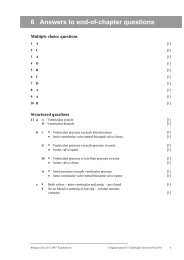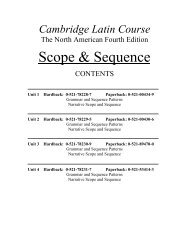Brad Philpot - Cambridge University Press
Brad Philpot - Cambridge University Press
Brad Philpot - Cambridge University Press
You also want an ePaper? Increase the reach of your titles
YUMPU automatically turns print PDFs into web optimized ePapers that Google loves.
3 Choose some of the other genres in the list above and carry out some further<br />
research on these types of novel. Make more Venn diagrams using the genres<br />
you have found out about.<br />
Historical fiction<br />
Historical fiction brings history to life by placing us, the readers, in a specific historical<br />
time and place. We see and experience the ideas of the times through the characters in the<br />
novel, enduring the same hardships and living their lives vicariously. As with all fiction,<br />
we must suspend our disbelief and not question how true the events or the characters are<br />
although we are always conscious that they are inspired by true events and real people.<br />
You are going to explore one novel of historical fiction to understand why its<br />
author chose to write this type of novel, and you will see how style and structure are<br />
influenced by the context in which the author wrote.<br />
Text 6.2 One Day in the Life of Ivan Denisovich, Alexander<br />
Solzhenitsyn, 1962<br />
While many in the West knew about the Soviet labour camps of the early 1950s, known<br />
as the gulags, it was not until One Day in the Life of Ivan Denisovich was published in<br />
1962 that the world really understood the hardships endured by so many prisoners in<br />
the USSR under Stalin. Solzhenitsyn was serving in the Red Army in 1945 when he was<br />
arrested for making derogatory remarks about Stalin in private letters to a friend. He<br />
was eventually imprisoned and sent to a labour camp close to Kazakhstan, where he<br />
experienced the cold, hunger and ill treatment described in his novella.<br />
When Stalin died in 1953, Solzhenitsyn was freed but exiled. In 1956 he was<br />
allowed to return to the USSR, where he taught in a secondary school. Solzhenitsyn<br />
submitted the manuscript of One Day in the Life of Ivan Denisovich in 1961 to the literary<br />
magazine Novy Mir, which had to seek approval from Krushchev and the government<br />
to publish the novella. As Stalin had by then fallen out of favour, the publication was<br />
approved. Solzhenitsyn won the Nobel Prize in 1970 but was not able to receive it until<br />
1974, when he was deported from the USSR for being anti-Soviet.<br />
No sense in getting your boots wet in the morning. Even if Shukhov had dashed<br />
back to his hut he wouldn’t have found another pair to change into. During eight<br />
years’ imprisonment he had known various systems for allocating footwear: there’d<br />
been times when he’d gone through the winter without valenki 1 at all, or leather<br />
boots either, and had had to make shift with bast sandals or a sort of galoshes<br />
made of scraps of motor tyres – ‘Chetezes’ they called them, after the Cheliabinsk<br />
tractor works. Now the footwear situation seemed better; in October Shukhov had<br />
received (thanks to Pavlo, whom he trailed to the store) a pair of ordinary, hardwearing<br />
leather boots, big enough for a double thickness of foot-cloth. For a week<br />
he went about as though he’d been given a birthday present, kicking his new<br />
heels. Then in December the valenki arrived, and, oh, wasn’t life wonderful?<br />
But some devil in the book-keeper’s office had whispered in the commandant’s<br />
ear that valenki should be issued only to those who surrendered their boots. It was<br />
against the rules for a prisoner to possess two pairs of footwear at the same time.<br />
So Shukhov had to choose. Either he’d have to wear leather throughout the winter,<br />
or surrender the boots and wear valenki even in the thaw. He’d taken such good<br />
Chapter 6 The context of composition<br />
The Plot<br />
Against<br />
America<br />
Etidorhpa<br />
Speculative<br />
fiction<br />
Science fiction<br />
2001: A Space<br />
Odyssey<br />
Fahrenheit<br />
451<br />
The<br />
Handmaid’s<br />
Tale<br />
Dystopian<br />
literature<br />
Animal<br />
Farm<br />
Figure 6.1 Venn diagrams can be useful<br />
when discussing genres and texts.<br />
Sample<br />
© <strong>Cambridge</strong> <strong>University</strong> <strong>Press</strong> 2011<br />
Figure 6.2 The Soviet writer Alexander<br />
Solzhenitsyn.<br />
141








